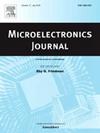Research on the ESD characteristics of symmetric DDSCR inserted with different floating heavy dopants
IF 1.9
3区 工程技术
Q3 ENGINEERING, ELECTRICAL & ELECTRONIC
引用次数: 0
Abstract
—Electrostatic (ESD) protection of high-voltage chips requires a high holding voltage to prevent the latching risk. The traditional Dual-direction Slicon Controlled Rectifier (DDSCR) is a commonly used device in high-voltage ESD protection. The traditional method to increase the holding voltage (Vh) of the device involves extending its anode and cathode spacing. However, it will increase the device footprint and decrease its efficiency. To avoid using the traditional method to increase the device's holding voltage, the ESD characteristics of five symmetric DDSCR structures with different floating heavy dopants are studied. Two-dimensional device simulation, breakdown voltage, and transmission line pulse (TLP) testing were used to verify the ESD protection performance of those devices. The experimental results indicate that compared with the traditional DDSCR, the DDSCR_PN structure achieves the highest holding voltages in both forward and reverse directions, measuring 21.6 V and 27.9 V, respectively, without sacrificing its current handling capability. The intrinsic reasons for the performance of these devices are also explained in this article.
不同悬浮重掺杂的对称DDSCR静电放电特性研究
—对高压芯片进行静电保护,需要较高的保持电压,以防止锁存风险。传统的双向硅控整流器(DDSCR)是高压ESD保护中常用的器件。提高器件保持电压(Vh)的传统方法包括延长其阳极和阴极间距。然而,它将增加设备占用空间并降低其效率。为了避免采用传统的方法来提高器件的保持电压,研究了五种不同浮重掺杂的对称DDSCR结构的ESD特性。通过二维器件仿真、击穿电压和传输线脉冲(TLP)测试验证了这些器件的ESD保护性能。实验结果表明,与传统的DDSCR相比,在不牺牲其电流处理能力的情况下,DDSCR_PN结构在正向和反向分别获得了21.6 V和27.9 V的最高保持电压。本文还解释了这些器件性能的内在原因。
本文章由计算机程序翻译,如有差异,请以英文原文为准。
求助全文
约1分钟内获得全文
求助全文
来源期刊

Microelectronics Journal
工程技术-工程:电子与电气
CiteScore
4.00
自引率
27.30%
发文量
222
审稿时长
43 days
期刊介绍:
Published since 1969, the Microelectronics Journal is an international forum for the dissemination of research and applications of microelectronic systems, circuits, and emerging technologies. Papers published in the Microelectronics Journal have undergone peer review to ensure originality, relevance, and timeliness. The journal thus provides a worldwide, regular, and comprehensive update on microelectronic circuits and systems.
The Microelectronics Journal invites papers describing significant research and applications in all of the areas listed below. Comprehensive review/survey papers covering recent developments will also be considered. The Microelectronics Journal covers circuits and systems. This topic includes but is not limited to: Analog, digital, mixed, and RF circuits and related design methodologies; Logic, architectural, and system level synthesis; Testing, design for testability, built-in self-test; Area, power, and thermal analysis and design; Mixed-domain simulation and design; Embedded systems; Non-von Neumann computing and related technologies and circuits; Design and test of high complexity systems integration; SoC, NoC, SIP, and NIP design and test; 3-D integration design and analysis; Emerging device technologies and circuits, such as FinFETs, SETs, spintronics, SFQ, MTJ, etc.
Application aspects such as signal and image processing including circuits for cryptography, sensors, and actuators including sensor networks, reliability and quality issues, and economic models are also welcome.
 求助内容:
求助内容: 应助结果提醒方式:
应助结果提醒方式:


